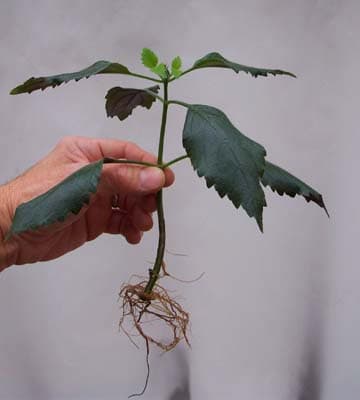Plant Propagation - Rooting Plants from Cuttings

Rooting Plants from Cuttings Works with Some Plants
Rooting plants is a common way to grow new plants from existing ones. Genetically, the new plant is identical to the mother plant. Take a stem cutting from the parent plant put it in a glass or jar with an inch or two of water. Usually, the plant is rooted in water. This propagation technique is called plant “rooting” or “growing cuttings”. Rooting new plants from cuttings is possible on a wide range of houseplants, bushes, and shrubs. For bushes and shrubs, if the stems are soft wooded, chances are they can be rooted to grow new plants. The list is long and includes popular plants like Roses, Lilacs, Pussy Willows, Rose of Sharon, and many more. Thus, I always tell growers when in doubt, to give it a try.
Did You Know? Some plants, like African Violets, work well with leaf cuttings. The leaf is either placed in water to root or placed directly into moist soil. Also, some leaf cuttings will grow pinned to the surface of the soil. Eventually, the new plants will root from the veins where they contact the moist soil.
Rooting Plants to Make New Ones is Easy
Rooting new plants is easy. As discussed above, most plant rootings are done in water. The most notable exception is roses, which are rooted in moist soil. Here is how most plants are rooted:
Select new, young sections of stems that are growing well.
Old wood, unhealthy stems, or stems with flowers on them are not good candidates for rooting.
Cut the end section of the stem off with a clean pair of shears or pruners.
Remove leaves at the bottom of the stem that might be underwater.
Immediately (and quickly) place the stems in a glass or jar of water. Pour an inch or two of water in the bottom of the container
Watch the water level to assure it doesn’t dry up. Add water as needed.
After the cuttings have developed some roots, transplant them into their new home in an indoor container, or outdoors in the garden or yard.
Note: Garden stores carry rooting compound. It aids root growth and development. It is useful with older plants and hard to root plants.
Did you know? Propagation by cuttings in a sense is “cloning”. It results in a genetic match with one mother (or donor) plant.
Seaweed fertilizer is beneficial for your young plants. It helps to promote a healthy root system. More on Seaweed fertilizer.
Also see: Rooting Houseplants
Plant Proagation from Root Separation
Root separation, or division of roots, is a similar process to rooting plants. Root separation is commonly practiced with perennial flower plants. Many perennial flowers are good candidates for root separation. The plants become overcrowded and need thinning from time to time.
Often, a friend sees the perennials and expresses interest in some of the beautiful plants. Eager to oblige a friend, gardeners dig up and separate the roots. They replant the separated clumps of roots or give them to the friends.
Cloning (rooting) Giant pumpkins to propagate “giant” genetics
Please support our site. Shop for:
- rmmatthews100@hotmail.com
- 585-721-6528
- Rochester, NY
©1999-2024 GardenersNet.Com, All Rights Reserved

